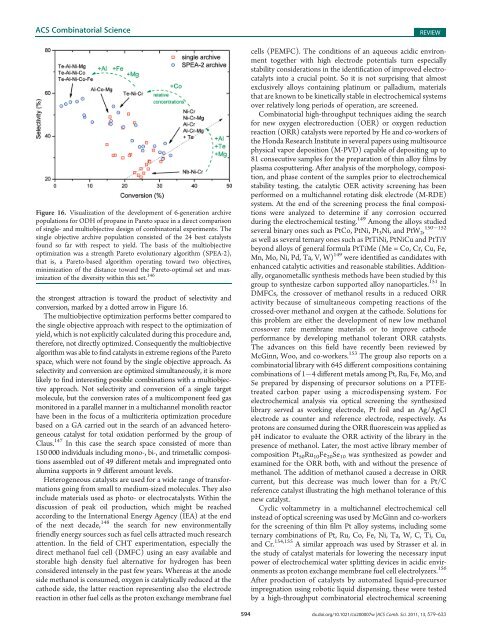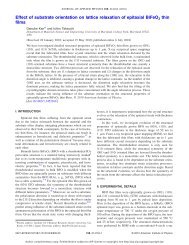Combinatorial and High-Throughput Screening of Materials ...
Combinatorial and High-Throughput Screening of Materials ...
Combinatorial and High-Throughput Screening of Materials ...
You also want an ePaper? Increase the reach of your titles
YUMPU automatically turns print PDFs into web optimized ePapers that Google loves.
ACS <strong>Combinatorial</strong> Science<br />
Figure 16. Visualization <strong>of</strong> the development <strong>of</strong> 6-generation archive<br />
populations for ODH <strong>of</strong> propane in Pareto space in a direct comparison<br />
<strong>of</strong> single- <strong>and</strong> multiobjective design <strong>of</strong> combinatorial experiments. The<br />
single objective archive population consisted <strong>of</strong> the 24 best catalysts<br />
found so far with respect to yield. The basis <strong>of</strong> the multiobjective<br />
optimization was a strength Pareto evolutionary algorithm (SPEA-2),<br />
that is, a Pareto-based algorithm operating toward two objectives,<br />
minimization <strong>of</strong> the distance toward the Pareto-optimal set <strong>and</strong> maximization<br />
<strong>of</strong> the diversity within this set. 146<br />
the strongest attraction is toward the product <strong>of</strong> selectivity <strong>and</strong><br />
conversion, marked by a dotted arrow in Figure 16.<br />
The multiobjective optimization performs better compared to<br />
the single objective approach with respect to the optimization <strong>of</strong><br />
yield, which is not explicitly calculated during this procedure <strong>and</strong>,<br />
therefore, not directly optimized. Consequently the multiobjective<br />
algorithm was able to find catalysts in extreme regions <strong>of</strong> the Pareto<br />
space, which were not found by the single objective approach. As<br />
selectivity <strong>and</strong> conversion are optimized simultaneously, it is more<br />
likely to find interesting possible combinations with a multiobjective<br />
approach. Not selectivity <strong>and</strong> conversion <strong>of</strong> a single target<br />
molecule, but the conversion rates <strong>of</strong> a multicomponent feed gas<br />
monitored in a parallel manner in a multichannel monolith reactor<br />
have been in the focus <strong>of</strong> a multicriteria optimization procedure<br />
based on a GA carried out in the search <strong>of</strong> an advanced heterogeneous<br />
catalyst for total oxidation performed by the group <strong>of</strong><br />
Claus. 147 In this case the search space consisted <strong>of</strong> more than<br />
150 000 individuals including mono-, bi-, <strong>and</strong> trimetallic compositions<br />
assembled out <strong>of</strong> 49 different metals <strong>and</strong> impregnated onto<br />
alumina supports in 9 different amount levels.<br />
Heterogeneous catalysts are used for a wide range <strong>of</strong> transformations<br />
going from small to medium-sized molecules. They also<br />
include materials used as photo- or electrocatalysts. Within the<br />
discussion <strong>of</strong> peak oil production, which might be reached<br />
according to the International Energy Agency (IEA) at the end<br />
<strong>of</strong> the next decade, 148 the search for new environmentally<br />
friendly energy sources such as fuel cells attracted much research<br />
attention. In the field <strong>of</strong> CHT experimentation, especially the<br />
direct methanol fuel cell (DMFC) using an easy available <strong>and</strong><br />
storable high density fuel alternative for hydrogen has been<br />
considered intensely in the past few years. Whereas at the anode<br />
side methanol is consumed, oxygen is catalytically reduced at the<br />
cathode side, the latter reaction representing also the electrode<br />
reaction in other fuel cells as the proton exchange membrane fuel<br />
REVIEW<br />
cells (PEMFC). The conditions <strong>of</strong> an aqueous acidic environment<br />
together with high electrode potentials turn especially<br />
stability considerations in the identification <strong>of</strong> improved electrocatalyts<br />
into a crucial point. So it is not surprising that almost<br />
exclusively alloys containing platinum or palladium, materials<br />
that are known to be kinetically stable in electrochemical systems<br />
over relatively long periods <strong>of</strong> operation, are screened.<br />
<strong>Combinatorial</strong> high-throughput techniques aiding the search<br />
for new oxygen electroreduction (OER) or oxygen reduction<br />
reaction (ORR) catalysts were reported by He <strong>and</strong> co-workers <strong>of</strong><br />
the Honda Research Institute in several papers using multisource<br />
physical vapor deposition (M-PVD) capable <strong>of</strong> depositing up to<br />
81 consecutive samples for the preparation <strong>of</strong> thin alloy films by<br />
plasma cosputtering. After analysis <strong>of</strong> the morphology, composition,<br />
<strong>and</strong> phase content <strong>of</strong> the samples prior to electrochemical<br />
stability testing, the catalytic OER activity screening has been<br />
performed on a multichannel rotating disk electrode (M-RDE)<br />
system. At the end <strong>of</strong> the screening process the final compositions<br />
were analyzed to determine if any corrosion occurred<br />
during the electrochemical testing. 149 Among the alloys studied<br />
150 152<br />
several binary ones such as PtCo, PtNi, Pt 3 Ni, <strong>and</strong> PtW 2 ,<br />
as well as several ternary ones such as PtTiNi, PtNiCu <strong>and</strong> PtTiY<br />
beyond alloys <strong>of</strong> general formula PtTiMe (Me = Co, Cr, Cu, Fe,<br />
Mn, Mo, Ni, Pd, Ta, V, W) 149 were identified as c<strong>and</strong>idates with<br />
enhanced catalytic activities <strong>and</strong> reasonable stabilities. Additionally,<br />
organometallic synthesis methods have been studied by this<br />
group to synthesize carbon supported alloy nanoparticles. 151 In<br />
DMFCs, the crossover <strong>of</strong> methanol results in a reduced ORR<br />
activity because <strong>of</strong> simultaneous competing reactions <strong>of</strong> the<br />
crossed-over methanol <strong>and</strong> oxygen at the cathode. Solutions for<br />
this problem are either the development <strong>of</strong> new low methanol<br />
crossover rate membrane materials or to improve cathode<br />
performance by developing methanol tolerant ORR catalysts.<br />
The advances on this field have recently been reviewed by<br />
McGinn, Woo, <strong>and</strong> co-workers. 153 The group also reports on a<br />
combinatorial library with 645 different compositions containing<br />
combinations <strong>of</strong> 1 4different metals among Pt, Ru, Fe, Mo, <strong>and</strong><br />
Se prepared by dispensing <strong>of</strong> precursor solutions on a PTFEtreated<br />
carbon paper using a microdispensing system. For<br />
electrochemical analysis via optical screening the synthesized<br />
library served as working electrode, Pt foil <strong>and</strong> an Ag/AgCl<br />
electrode as counter <strong>and</strong> reference electrode, respectively. As<br />
protons are consumed during the ORR fluorescein was applied as<br />
pH indicator to evaluate the ORR activity <strong>of</strong> the library in the<br />
presence <strong>of</strong> methanol. Later, the most active library member <strong>of</strong><br />
composition Pt 50 Ru 10 Fe 20 Se 10 was synthesized as powder <strong>and</strong><br />
examined for the ORR both, with <strong>and</strong> without the presence <strong>of</strong><br />
methanol. The addition <strong>of</strong> methanol caused a decrease in ORR<br />
current, but this decrease was much lower than for a Pt/C<br />
reference catalyst illustrating the high methanol tolerance <strong>of</strong> this<br />
new catalyst.<br />
Cyclic voltammetry in a multichannel electrochemical cell<br />
instead <strong>of</strong> optical screening was used by McGinn <strong>and</strong> co-workers<br />
for the screening <strong>of</strong> thin film Pt alloy systems, including some<br />
ternary combinations <strong>of</strong> Pt, Ru, Co, Fe, Ni, Ta, W, C, Ti, Cu,<br />
<strong>and</strong> Cr. 154,155 A similar approach was used by Strasser et al. in<br />
the study <strong>of</strong> catalyst materials for lowering the necessary input<br />
power <strong>of</strong> electrochemical water splitting devices in acidic environments<br />
as proton exchange membrane fuel cell electrolyzers. 156<br />
After production <strong>of</strong> catalysts by automated liquid-precursor<br />
impregnation using robotic liquid dispensing, these were tested<br />
by a high-throughput combinatorial electrochemical screening<br />
594 dx.doi.org/10.1021/co200007w |ACS Comb. Sci. 2011, 13, 579–633












